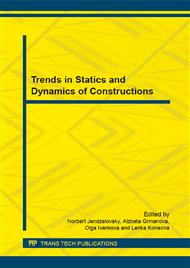p.139
p.145
p.153
p.161
p.166
p.172
p.180
p.185
p.192
Different Approaches to Modeling of Proportional Damping
Abstract:
This article is focused on the comparison of mathematical models, which are usable for description of damping in the linear proportional systems with single and multi degrees of freedom (SDOF and MDOF). The viscous and hysteretic models have been applied on the SDOF system. The hysteretic damping, Rayleigh's and Caughey's damping matrices have been mentioned and considered for modeling of damping in systems with more than one degree of freedom. The wellknown Rayleigh's model is proportional to the mass and stiffness matrices. Caughey's model is more general than Rayleigh's. This model is able to prescribe an arbitrary number of damping ratios, but on the other hand using odd number of members in Caughey's series should not be allowed due to the negative values of damping ratios in higher modes, which brings self exciting effect. The hysteretic model is defined only in the frequency domain therefore the frequency response functions of each model have been compared.
Info:
Periodical:
Pages:
166-171
Citation:
Online since:
June 2015
Authors:
Price:
Сopyright:
© 2015 Trans Tech Publications Ltd. All Rights Reserved
Share:
Citation:


